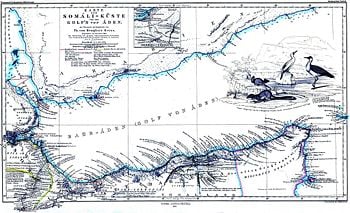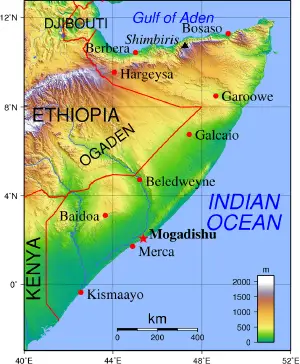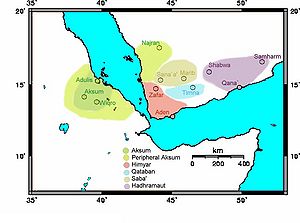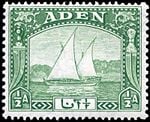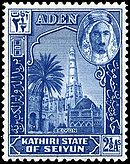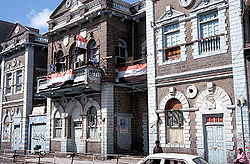Gulf of Aden
The Gulf of Aden is located in the Indian Ocean between Yemen on the south coast of the Arabian Peninsula and Somalia in Africa. In the northwest it connects with the Red Sea through the Bab el Mandeb sound.
The Gulf of Aden is an essential waterway for Persian Gulf oil, making it very important for the world ecomomy. It has many varieties of fish, coral, and other creatures since there is little pollution. The main ports are Aden (in Yemen), Berbera, and Bosaso (both in Somalia). In ancient times, Crater was an important port.
It is one of the main areas in the world where acts of piracy are regularly committed, making it dangerous for sailing. Moreover, various attacks have been carried out in the Gulf, such as the USS Cole' bombing.
Geography
The Gulf of Aden is located in the Indian Ocean between Yemen on the south coast of the Arabian Peninsula and Somalia and Djibouti in Africa. In the northwest it connects with the Red Sea through the Bab el Mandeb sound.
Sometimes known as the western arm of the Arabian Sea or the Indian Ocean, the gulf runs in a west-east direction between Yemen and Somalia, meeting Djibouti at the western end, where it is only 12 miles (20 km) from the coast of Djibouti to Yemen.. It is about 900 km long, and 500 km wide at the eastern end, between Ra's Asir of Somalia and the city of al-Mukalla of Yemen.
Somalia's location along the southern approaches to Bab el Mandeb and the route through the Red Sea and Suez Canal makes it strategically important. The Somali Democratic Republic, which forms the Horn of Africa, has a coastline approximately 3300 km long, bounded on the north by the Gulf of Aden and on the east by the Indian Ocean. The total area of the country is 637,657 sq km, with a population of approximately 5.4 million. The coastal ecosystems and habitats vary widely from north to south. Along the Gulf of Aden to Ras Hafun, there are large expanses of sandy beach alternating with rocky outcrops and coastal plain.
The Bay of Tadjoura juts out at the western end, into Djbouti.
The Yemeni coastline bordering the Gulf of Aden is dominated by rocky cliffs alternating with long stretches of littoral and sub-littoral sand along coastal plains. Some of the sandy beaches, notably Ras Sharma and Dhobbah (Ash Shihr) of Yemen, form major nesting sites for green turtles in the Region.
Aden lies on a major world trading route through the Suez Canal. It is one of the largest natural harbors in the world with an area of about 70 sq. km of sheltered water.
Monsoon winds blow from the southwest from May to September and from the northeast from November to April.
The Gulf of Aden is strongly influenced by the upwelling of cool, nutrient rich waters during the southwest and northeast monsoons and is characterized by a prevailing high energy climate. These pose major constraints on coral reef development, hence only 5 percent of the Yemeni Gulf of Aden coast is lined with fringing reefs. Rocky cliffs alternating with long stretches of littoral and sub–littoral sand along coastal plains dominate the coastline. Some of the sandy beaches, notably Ras Sharma and Dhobbah (Ash Shihr) of Yemen, form major nesting sites for green turtles in the Region. Little is known about the coastal and marine resources of the Gulf of Aden coast of Somalia although recent visits have revealed the occurrence of previously unknown coral reefs and mangrove stands.
Situated at the eastern extreme of the Gulf of Aden, the Socotra Archipelago, which is part of Yemen, is of global significance for island biodiversity and species endemism. Over one third of its plants are endemic to the archipelago, making it one of the top ten island groups in the world in terms of endemism. Many of these endemics are remnants of an ancient flora that long ago disappeared from the African–Arabian mainland. Unlike many island groups, Socotra has remained virtually untouched by modern development and there is no evidence of recent extinction or large–scale changes in the vegetation. The marine environments of Socotra Archipelago remain largely in a pristine state, unaltered by coastal pollution or over–exploitation.
About 130 species of coral reef have been reported in the southern Red Sea and Gulf of Aden.
There are extensive mangrove stands in the Red Sea and Gulf of Aden, especially in the southern Red Sea. Mangroves are an extremely important form of coastal vegetation: their extensive root systems stabilize sediments and protect the coastline; they provide shelter for an array of marine animals, birds—enhancing overall biodiversity—and the juveniles of commercially important fish and crustaceans.
Djibouti, which lies, at the junction of the Red Sea and the Gulf of Aden, has an area of 23,000 km2 and a coastline of about 370 km in length. The northern coast between the Eritrean border and Ras- Bir faces the narrow Strait of Bab al Mandab. Most of the coastline of Djibouti lies along the narrow Gulf of Tadjourah, an east-west oriented trench with a maximum depth of 883 m. A shallow, but narrow opening separates it from the semi-enclosed basin of the Goubet al-Kharab, which has increased salinity and coral reefs of low species diversity. For most of the year, surface salinity is about 36.5 ppt.
The relatively high turbidity generally limits coral growth to the upper 15 to 25 m, although corals have been reported from depths below 35 m.
At the entrance to the Gulf of Tadjourah, north of the town of Djibouti, a large reef plateau forms the base of the islands of Musha and Maskali, which are surrounded by extensive coral reefs. The southeastern coast between the capital and Loyada at the Somali border is rather shallow and sandy with several estuaries. This area lies in a zone of upwelling nutrient-rich water where coral reefs are poorly developed.
The coral reefs are mostly fringing. The reef edge presents variable width. Morphologically, around Musha and Maskali, the actual coral formations are ended by an active cliff, completely alive, reaching 15 m. Beyond this formation, the reef slope is covered by sand and mud.
The estimated population of the Republic of Djibouti in 1994 was about 540,000. There are three coastal towns in Djibouti, namely, Djibouti, Tagora and Obek. The population of Djibouti, the main coastal city, is about 400,000.
With similar conditions to those prevailing in the southern reefs of the Red Sea, the reef of Djibouti is very turbid. On the south coast, close to the border with Somalia, the effects of upwelling nutrient-rich water begin to be discernible in fish assemblages. Water there is very turbid and the reefs poorly developed. They support fewer species and lower abundances of reef-associated fish than reefs further north. Non-reef species are more abundant, however, and this area represents the main artisanal fishing ground in Djibouti.
History
The Gulf of Aden has been a part of world trade since ancient times. Arab and Indian sailors had taken advantage of seasonal monsoon winds, and ancient Greeks had also made the trip. Roman sailors started using the Red Sea route to Asia following the conquest of Egypt and expanded the quantity of trade involved, enough to justify a handbook of trade routes entitled Periphus maris Erythraei. The Erythraean Sea, as it was known then, encompassed the Gulf of Aden, and Indian Ocean, in addition to the Red Sea. Few traders rounded the Horn of Africa and traversed the Gulf of Aden to continue down the coast of Africa, however. The route to India was faster and more lucrative.
But trade between the Sabeans at the tip of the Arabian Peninsula and the budding civilizations of Africa predated Roman times. The series of kingdoms in southern Arabia culminated in the kingdom of Saba, which was responsible for a number of innovations in agriculture, including irrigation and use of the ox-drawn plow. The plow is believed to have crossed the Gulf of Aden to Ethiopia, and the Sabean influence on Ethiopia's language is unmistakable. Inscriptions found in the Ethiopian highlands and dated to the seventh century B.C.E. are deemed Sabean in style and content. The developing kingdom of Axum, centered in the Ethiopian highlands, absorbed these elements of civilization.
The port of Aden
Aden is a city in Yemen, 105 miles (170 km) east of Bab-el-Mandeb.
Aden's ancient, natural harbor lies in the crater of an extinct volcano which now forms a peninsula, joined to the mainland by a low isthmus. This harbor, Front Bay, was first used by the ancient Kingdom of Awsan between the 5th and 7th centuries B.C.E. The modern harbor is on the other side of the peninsula. Aden now has a population of about 590,000.
Aden consists of a number of distinct sub-centers: Crater, the original port city; Ma'alla, the modern port; Tawahi, known as "Steamer Point" in colonial days; and the resorts of Gold Mohur. Khormaksar, located on the isthmus that connects Aden proper with the mainland, includes the city's diplomatic missions, the main offices of Aden University, and Aden International Airport—the former RAF Khormaksar. On the mainland are the sub-centers of Sheikh Othman, a former oasis area; Al-Mansura, a town planned by the British; and Madinat ash-Sha'b, the site designated as the capital of the South Arabian Federation and now home to a large power/desalinization facility and additional faculties of Aden University.
Aden encloses the eastern side of a vast, natural harbor that comprises the modern port. The volcanic peninsula of Little Aden forms a near-mirror image, enclosing the harbor and port on the western side. Little Aden became the site of the oil refinery and tanker port. Both were established and operated by British Petroleum until they were turned over to Yemeni government ownerships and control in 1977.
Aden was the capital of the People's Democratic Republic of Yemen until that country's unification with the Yemen Arab Republic when it was declared a free trade zone. It gives its name to the Gulf of Aden.
History
Antiquity
The port's convenient position on the sea route between India and Europe has made Aden desirable to rulers who sought to possess it at various times throughout history. Known as Arabian Eudaemon in the 1st century B.C.E., it was a transshipping point for the Red Sea trade, but fell on hard times when new shipping practices by-passed it and made the daring direct crossing to India in the 1st century AD, according to the Periplus of the Erythraean Sea. The same work describes Aden as 'a village by the shore', which would well describe the town of Crater while it was still little-developed. There is no mention of fortification but at this stage, Aden was more an island than a peninsula as the isthmus (a tombolo) was not then so developed as it is today.
Medieval
Although the pre-Islamic civilization of Himyar was capable of building large structures, there seems to have been little fortification at this stage. Fortifications at Mareb and other places in Yemen and the Hadhramaut make it clear that it and the Sabean culture were well capable of it. Thus watch towers, since destroyed, are possible. However, the Arab historians Ibn al Mojawir and Abu Makhramah attribute the first fortification of Aden to Beni Zuree'a. The aim seems to have been twofold: to keep hostile forces out and to maintain revenue by controlling the movement of goods—preventing smuggling. In its original form, some of this work was relatively feeble, but after 1175 C.E., rebuilding in a more solid form began.
In 1421 Ming dynasty Yongle Emperor ordered principle envoy grand eunuch Li Xing and grand eunuch Zhou Man of Zheng He fleet to convey an imperial edict with hats and robes to bestow on the king of Aden. The envoys boarded three treasure ships and set sail from Sumatra to the port of Aden. This event was recorded in the book Ying-yai Sheng-lan by Ma Huan who accompanied the imperial envoy.[1]
British Rule
In 1838, Sultan Muhsin bin Fadl of the nearby state of Lahej ceded 194 km² (75 sq. miles) including Aden to the British. On 19 January 1839, the British East India Company landed Royal Marines at Aden to occupy the territory and stop attacks by pirates against British shipping to India. The port lies about equidistant from the Suez Canal, Bombay (Mumbai), and Zanzibar, which were all important former British possessions. Aden had been an entrepôt and a way-station for seamen in the ancient world. There, supplies, particularly water, were replenished. So, in the mid-nineteenth century, it became necessary to replenish coal and boiler water. Thus Aden acquired a coaling station at Steamer Point. Aden was to remain under British control until 1967.
Until 1937, Aden was ruled as part of British India and was known as the Aden Settlement. Its original territory was enlarged in 1857 by the 13 km² island of Perim, in 1868 by the 73 km² Khuriya Muriya Islands, and in 1915 by the 108 km² island of Kamaran.
In 1937, the Settlement was detached from India and became the Colony of Aden, a British crown colony. The change in government was a step towards the change in monetary units seen in the stamps illustrating this article. When The Indian Empire went its independent ways, Indian rupees (divided into annas) were replaced in Aden by East African shillings. The hinterland of Aden and Hadhramaut were also loosely tied to Britain as the Aden Protectorate which was overseen from Aden.
Aden's location also made it a useful entrepôt for mail passing between places around the Indian Ocean and Europe. Thus, a ship passing from Suez to Bombay could leave mail for Mombasa at Aden for collection. See History of postage in Aden.
After the loss of the Suez Canal in 1956, Aden became the main base in the region for the British.
In order to stabilize Aden and the surrounding Aden Protectorate from the designs of North Yemen, the British attempted to gradually unite the disparate states of the region in preparation for eventual independence. On 18 January 1963, the Colony of Aden was incorporated into the Federation of Arab Emirates of the South against the wishes of much of the city's populace as the State of Aden and the Federation was renamed the Federation of South Arabia (FSA).
An insurgency against British rule known as the Aden Emergency began with a grenade attack by the National Liberation Front (NLF) against the British High Commissioner on December 10, 1963, killing one person and injuring fifty, and a "state of emergency" was declared.
In 1964, Britain announced its intention to grant independence to the FSA in 1968, but that the British military would remain in Aden.
In January 1967, there were mass riots by the NLF and the rival Front for the Liberation of Occupied South Yemen (FLOSY) supporters in the old Arab quarter of Aden town, which continued until mid February, despite the intervention of British troops. During the period there were many attacks on the troops, and an Aden Airlines DC3 plane was destroyed in the air with no survivors.
On November 30, 1967 the British finally pulled out, leaving Aden and the rest of the FSA under NLF control. The Royal Marines, who had been the first British troops to occupy Aden in 1839, were the last to leave — with the exception of a Royal Engineer detachment.
Independence
Aden became the capital of the new People's Republic of South Yemen which was renamed the People's Democratic Republic of Yemen in 1970. With the unification of northern and southern Yemen in 1990, Aden was no longer a national capital but remained the capital of Aden Governorate which covered an area similar to that of the Aden Colony.
On December 29, 1992, Al Qaeda conducted its first known terrorist attack in Aden, bombing the Gold Mohur Hotel, where U.S. servicemen were known to have been staying en route to Somalia for Operation Restore Hope. A Yemeni and an Austrian tourist died in the attack.
Aden was briefly the center of the secessionist Democratic Republic of Yemen from 21 May 1994 but was reoccupied by Republic of Yemen troops on 7 July 1994.
Members of al Qaeda attempted to bomb USS The Sullivans at the port of Aden as part of the 2000 millennium attack plots. The boat that had the explosives in it sank, forcing the planned attack to be aborted. The USS Cole bombing occurred in Aden on October 12, 2000.
Economy
In the 1800's, Aden grew as a ship fueling port, holding stocks of coal and water supplies for the early steamers. Port services expanded after the Suez Canal opened in 1869, and Aden grew to become one of the busiest ship bunkering and tax-free-shopping and trading ports in the world by the 1950s. Barges took cargo between ships berthed in the Inner Harbor and the wharves. Coastal vessels and dhows carried cargoes to and from regional ports.
In the 1970s, with the Suez Canal closed until 1975, Aden declined under intense competition from new ports in the region and changes in the patterns of trade. New quays were urgently needed at Aden to serve modern cargo demands. These were built at the end of the 1980s at the Ma'alla Terminal. After over 150 years of commercial activity, Aden finally had the capacity and equipment to handle all types of dry cargo at deep alongside berths served by modern container cranes.
Since unification in 1990, significant and positive changes in the country are leading to rapid privatization, higher investment, and growing manufacturing output to meet national and overseas demand. The advantages of Aden for container transshipment have been recognized.
To handle the world's largest container vessels, the Aden Container Terminal (ACT) at the North Shore of Aden's Inner Harbor was designed and built. This facility was commissioned in March 1999 and provides the port with world-class container-handling facilities. ACT's throughput is expected to increase from 500,000 TEU's/year in 2001 to an anticipated 3 million plus early in the next millennium.
Artisanal fishermen have fished the Region’s waters for thousands of years in a sustainable manner and in many places continue to do so with little advancement in technology. These artisanal fishermen have established forms of traditional management of their resources, including the rotation of fishing activities among reefs to prevent over–fishing and decline of stocks. An extensive knowledge of the sea, fishing techniques, and habits of species caught by fishermen are retained by a few individuals who serve as leaders in each fishing community. In a few places the tradition of pearl diving continues, although the number of divers is dwindling. This part of the Region’s cultural heritage is at risk of disappearing in some localities as local fishermen are replaced by foreign workers, prices for fish fall, and competition with industrial fisheries grows.
Issues
Several factors thus continue to threaten the region’s richness and biodiversity. Today, supertankers cruise this historical trading route transporting oil and other dangerous cargoes around the world. The potential for accidents that might release oil or other toxic chemicals into the marine environment is addressed by PERSGA in cooperation with several international bodies. Those waters, with their unique habitats and their animal and plant communities, are thus placed in increasing jeopardy each day as a result of oil and effluent pollution.
Humans also pose another threat to marine life in the region. Fishermen, for instance, tend to catch turtles for their meat and eggs. Local recreational use of beaches in some areas also results in disturbing or even killing nesting turtles. More so, the shark resources of the region are heavily fished. In some places, there is growing evidence of depletion, which is attributed to a lack of control over national shark fisheries and an illegal fishing by fishermen who also catch sharks using gillnets and long-lines, thus causing damage to coral reefs.
Furthermore, illegal fishing by vessels operating outside their natural waters is commonplace. The absence of effective control, surveillance and enforcement of regulations has thus resulted in widespread poaching and habitat destruction by foreign and national vessels. There also lies the problem of national over-exploitation as well as concentration of fishing within limited waters, which leads to a reduction in the number and diversity of fish as well as to habitat destruction in some cases.
As to navigation risks involved, coral reefs form natural barriers to ships traveling through the Red Sea on their way to or from the Suez Canal. The coral is so extensive in some areas that only narrow channels remain, which can be quite hazardous. Many southern harbors are partially blocked by reefs. The ever-presence of oil tankers in such routes increases the risk of a disaster to happen if one of them hits a coral reef. This leads again to the ever-present threat of pollution by oil, sewage and chemical effluents.
Industrial activities and urban development also pose threats to the region’s marine life in the form of industrial and urban pollution, waste disposal, surface and ground water usage and saltwater intrusion to aquifers. Agriculture also threatens the marine environment through increased sedimentation and the potential pollution from pesticide and fertilizer residues. All the above mentioned threats could lead to habitat destruction due to coastal development, pond construction for shrimp and fish culture, mangrove destruction, damage for coral reefs through unsustainable fishing practices, removal of coral for the tourist trade and physical damage caused by tourist divers.
Aden is 4km from the main east-west shipping route. Ideal port for large main line vessels wanting to reduce the number of ports served directly and save on sailing times. It takes 9 days steaming from Europe and 7 days from Singapore by modern container ships.
Definitely, it is the perfect choice as transshipment hub and spoke operational base creating services for smaller and feeder vessels to ports in the Red Sea, the Arabian Sea, the Indian Ocean, the Gulf, South and East Africa.
Efficiently offers facilities and services such as bunkers, supplies, emergency services and assistance at short notice, expeditiously and cost effectively
The major threats to the marine environment of the Red Sea and Gulf of Aden are related to land-based activities. These include urbanization and coastal development (for example, dredge and fill operations), industries including power and desalination plants and refineries, recreation and tourism, waste water treatment facilities, power plants, coastal mining and quarrying activities, oil bunkering and habitat modification such as the filling and conversion of wetlands.
Sources and further reading
- Reader, John. 1998. Africa: A Biography of the Continent. New York: Alfred A. Knopf. ISBN 0679409793
External Links
- [1] Regional Organization for the Conservation of the Environment of the Red Sea and Gulf of Aden
- [2] Port of Aden
- [3] United Nations Environment Programme
- [4] Status of Coral Reefs in the Red Sea-Gulf of Aden
Credits
New World Encyclopedia writers and editors rewrote and completed the Wikipedia article in accordance with New World Encyclopedia standards. This article abides by terms of the Creative Commons CC-by-sa 3.0 License (CC-by-sa), which may be used and disseminated with proper attribution. Credit is due under the terms of this license that can reference both the New World Encyclopedia contributors and the selfless volunteer contributors of the Wikimedia Foundation. To cite this article click here for a list of acceptable citing formats.The history of earlier contributions by wikipedians is accessible to researchers here:
The history of this article since it was imported to New World Encyclopedia:
Note: Some restrictions may apply to use of individual images which are separately licensed.
- ↑ Ma Huan Ying-yai Sheng-lan, The Overall Survey of the Ocean's Shores, 1433, translated by J.V.G. Mills, with foreword and preface, Hakluty Society, London 1970; reprinted by the White Lotus Press 1997. ISBN 974-8496-78-3
